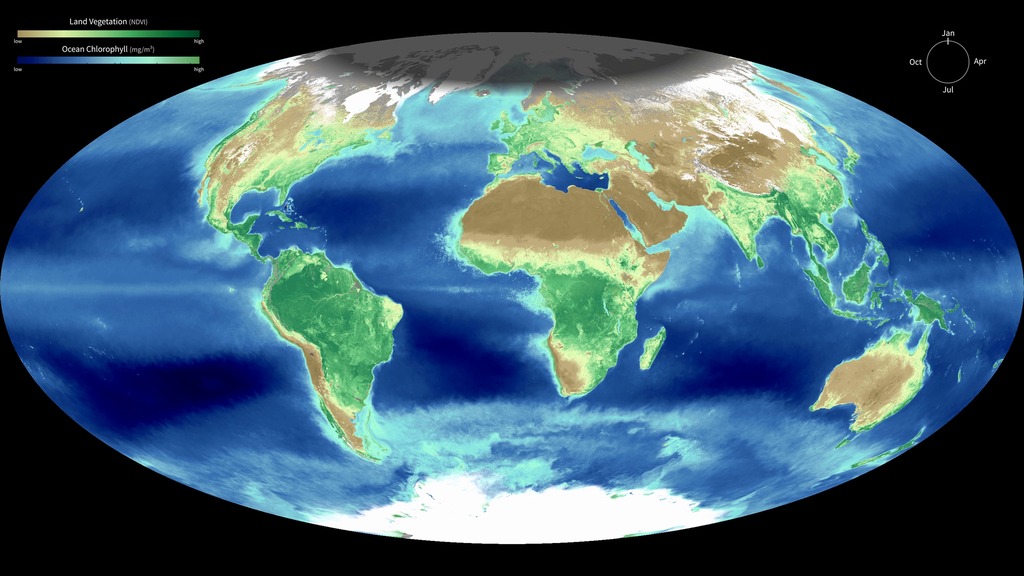Global Biosphere, Yearly Cycle
A different color scheme to differentiate ocean and land.
Satellite instruments reveal the yearly cycle of plant life on the land and in the water. On land, the images represent the density of plant growth, while in the ocean they show the chlorophyll concentration from tiny, plant-like organisms called phytoplankton. From December to February, during the Northern Hemisphere winter, plant life in the higher latitudes is minimal. The region shaded dark gray shows areas receiving no sunlight, and snow and ice cover much of those areas. However even in the midlatitudes, plants are dormant, shown here with browns and yellows on the land and dark to mid blues in the ocean. By contrast the Southern Ocean and land masses are at the height of the summer season and plant life is revealed with dark green colors on the land and bright teal in the ocean. As the year progresses, the situations reverses, with plant life following the increased sunlight northward, while the Southern Hemisphere experiences decreased plant activity during its winter.
These images are generated by combining data from many satellite instruments and averaging them over a period of nearly 10 years.
Data Sources include:
Land BioProductivity - VIP01P4 - A long term data record for Vegetation Phenology.
http://vip.arizona.edu/
1980-2010, running 7 day average
Ocean Color - GSMChl - a multi-satellite ocean color product made using Level 3, daily, binned imagery from SeaWiFS, MODIS-Aqua, Meris, and Viirs.
http://wiki.icess.ucsb.edu/measures/GSM
2003-2010, 29 day running average
Cryosphere data are:
Sea Ice - AMSR-E/Aqua Daily Sea Ice concentration
http://nsidc.org/data/AE_SI12
2002-2011, running 5-day average
Snow - IMS Daily Northern Hemisphere Snow and Ice Analysis
http://nsidc.org/data/G02156
2006-2014, running 29 day average
The supporting static/still data are used to show the permenent cryosphere features. They are:
Antarctic Icesheet - LIMA - Landsat Image Mosaic of Antarctica, this mosaic was created from Landsat images collected primarily during 1999–2003.
http://lima.usgs.gov
images collected primarily during 1999–2003.
Greenland Icesheet - MODIS composite from 2011 - this is a cloud-free mosaic from several images from summer 2011
Summer 2011
Glaciers - GLIMs glacier database
http://nsidc.org/data/nsidc-0272
Version without snow and sea ice
Yearly cycle of plant growth.
Credits
Please give credit for this item to:
NASA/Goddard Space Flight Center, The SeaWiFS Project and GeoEye. NOTE: All SeaWiFS images and data presented on this web site are for research and educational use only. All commercial use of SeaWiFS data must be coordinated with GeoEye (NOTE: In January 2013, DigitalGlobe and GeoEye combined to become DigitalGlobe).
-
Visualizer
Release date
This page was originally published on Sunday, April 12, 2015.
This page was last updated on Sunday, February 2, 2025 at 11:37 PM EST.
Datasets used
-
IMS Daily Northern Hemisphere Snow and Ice Analysis (IMS Daily Northern Hemisphere Snow and Ice Analysis - 24 km Resolution) [Interactive Multisensor Snow and Ice Mapping System (IMS)]
ID: 778This dataset can be found at: http://nsidc.org/data/docs/noaa/g02156_ims_snow_ice_analysis/
See all pages that use this dataset -
GSMchl (GSM Chlorophyll Concentration) [SeaWiFS, Meris, and MODIS-Aqua]
ID: 892
Note: While we identify the data sets used on this page, we do not store any further details, nor the data sets themselves on our site.
